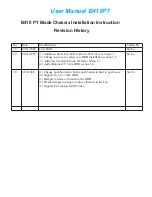
1-3
Cisco ASA Series CLI Configuration Guide
Chapter 1 Configuring Multiple Context Mode
Information About Security Contexts
How the ASA Classifies Packets
Each packet that enters the ASA must be classified, so that the ASA can determine to which context to
send a packet. This section includes the following topics:
•
Valid Classifier Criteria, page 1-3
•
Classification Examples, page 1-4
Note
If the destination MAC address is a multicast or broadcast MAC address, the packet is duplicated and
delivered to each context.
Valid Classifier Criteria
This section describes the criteria used by the classifier and includes the following topics:
•
•
Unique MAC Addresses, page 1-3
•
Note
For management traffic destined for an interface, the interface IP address is used for classification.
The routing table is not used for packet classification.
Unique Interfaces
If only one context is associated with the ingress interface, the ASA classifies the packet into that
context. In transparent firewall mode, unique interfaces for contexts are required, so this method is used
to classify packets at all times.
Unique MAC Addresses
If multiple contexts share an interface, then the classifier uses unique MAC addresses assigned to the
interface in each context. An upstream router cannot route directly to a context without unique MAC
addresses. By default, auto-generation of MAC addresses is enabled. You can also set the MAC
addresses manually when you configure each interface.
NAT Configuration
If you disable use of unique MAC addresses, then the ASA uses the mapped addresses in your NAT
configuration to classify packets. We recommend using MAC addresses instead of NAT, so that traffic
classification can occur regardless of the completeness of the NAT configuration.
Summary of Contents for 5505 - ASA Firewall Edition Bundle
Page 28: ...Glossary GL 24 Cisco ASA Series CLI Configuration Guide ...
Page 61: ...P A R T 1 Getting Started with the ASA ...
Page 62: ......
Page 219: ...P A R T 2 Configuring High Availability and Scalability ...
Page 220: ......
Page 403: ...P A R T 2 Configuring Interfaces ...
Page 404: ......
Page 499: ...P A R T 2 Configuring Basic Settings ...
Page 500: ......
Page 533: ...P A R T 2 Configuring Objects and Access Lists ...
Page 534: ......
Page 601: ...P A R T 2 Configuring IP Routing ...
Page 602: ......
Page 745: ...P A R T 2 Configuring Network Address Translation ...
Page 746: ......
Page 845: ...P A R T 2 Configuring AAA Servers and the Local Database ...
Page 846: ......
Page 981: ...P A R T 2 Configuring Access Control ...
Page 982: ......
Page 1061: ...P A R T 2 Configuring Service Policies Using the Modular Policy Framework ...
Page 1062: ......
Page 1093: ...P A R T 2 Configuring Application Inspection ...
Page 1094: ......
Page 1191: ...P A R T 2 Configuring Unified Communications ...
Page 1192: ......
Page 1333: ...P A R T 2 Configuring Connection Settings and QoS ...
Page 1334: ......
Page 1379: ...P A R T 2 Configuring Advanced Network Protection ...
Page 1380: ......
Page 1475: ...P A R T 2 Configuring Modules ...
Page 1476: ......
Page 1549: ...P A R T 2 Configuring VPN ...
Page 1550: ......
Page 1965: ...P A R T 2 Configuring Logging SNMP and Smart Call Home ...
Page 1966: ......
Page 2059: ...P A R T 2 System Administration ...
Page 2060: ......
Page 2098: ...1 8 Cisco ASA Series CLI Configuration Guide Chapter 1 Troubleshooting Viewing the Coredump ...
Page 2099: ...P A R T 2 Reference ...
Page 2100: ......



































